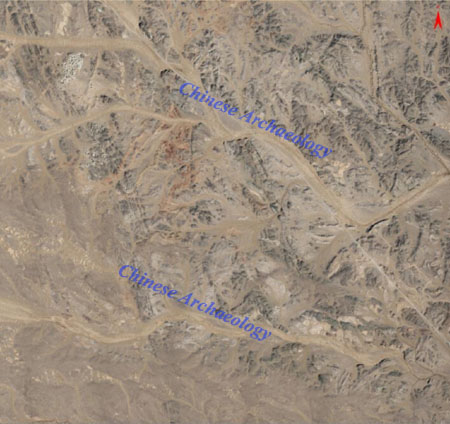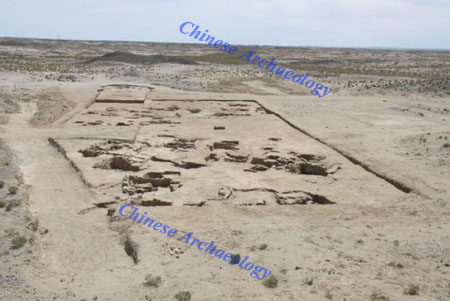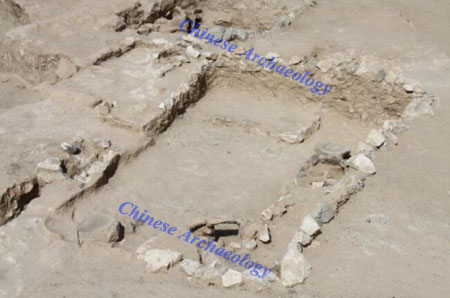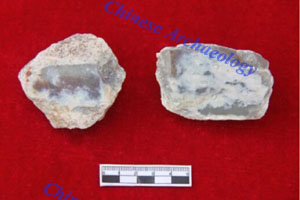Complete Jade Workshop Remains Found at Mazongshan Jade Mine Site in Guansu province
From:Chinese Archaeology NetWriter:Date:2015-01-19
From 2011 to 2014, Guansu Provincial Institute of Archaeology conducted an archaeological research and excavation to Mazongshan Jade Mine Site, located in Subei county, Guansu province, for four consecutive years. It is currently confirmed that, the site is about 5400 meters’ long, between 1400 and 1850 meters’ wide, with a perimeter of more than 13500 meters and an area of about 600 square meters.

Striograph of Jingbaoer Pasture Jade Mine Site

Overall view of the Jingbaoer Pasture Jade Mine Site
Two jade mine sites, Jingbaoer Pasture and Hanyaozi Pasture, are confirmed in Mazongshan town.
Jingbaoer Pasture Jade Mine Site is located at Jingbaoer pasture, about 20 kilometers northeast of Mazongshan town. The remains are distributed along the northwest-southeast direction as a whole, according to the vein. According to the survey, there found 383 remains, including 290 mine pits, 33 house foundations, 31 guard posts, 29 stone piling-ups. The types of the pits are shallow pits, deep wells and tunnels. There are 266 old mine pits, all opencast mining, including 240 shallow pits and 26 tunnels. The guard posts are located on higher grounds, most of which are on the top of the hills. The plane is rectangular, with stones piled up to be parapets, and the parapets are between 80 and 100 centimeters’ wide, most of them are 30 centimeters’ high, with an area of from less than 5 to more than 20 square meters. Inside and around which, stone implements, jade pieces, pottery shard, etc. were found.

Semi-subterrane workshop foundation F22 at Jingbaoer Pasture Jade Mine Site
Until 2014, the excavation area is more than 2000 square meters in the Jingbaoer Pasture Site, clearing up more than 100 house foundations, ash pits and etc, among which the houses are the most characteristic. So far, 31 houses were found, divided into ground and semi-subterrane types, most of them are semi-subterrane houses. After examined, most of the semi-subterrane houses were used as the workshops for sorting the jade materials, and they were mostly distributed in groups, with rectangular plane, single or suite. Workshops consist of post holes, gateway, storage pits, earth-platforms, operating platforms, hearths, etc. Different types of whetstones, jade pieces, stone shards and other materials were left on the ground, and fire burned traces can be seen obviously on part of the floor, with ashes left. Through excavations, a number of workshops with clear stratigraphic relationship were found, gaining the relations of broken and overlapped between different groups of houses, finding out the phenomenon that many houses were reused after reconstruction.

Semi-subterrane jade workshops F3~F5 at Jingbaoer Pasture Jade Mine Site
The unearthed relics are pottery, copperware, golden pieces, ironware, stoneware, jade materials, etc. Two types of pottery shard were found, the Han dynasty ones and Shanma Culture ones. The largest amount of Jade materials is tremolite, and the productions mainly are green jade and Hetian jade with caramel color, the smallest is white jade, some of materials were polished. Stone artifacts are mainly hammers, axes, choppers, whetstone, etc. The materials of the whetstone are mainly sandstone, some are slate, with various sizes and shapes. Copperware is mainly arrow-heads. Ironware includes arrow-heads, spear-heads, swords, and fragments of tools, etc. Also fragments made of both copper and iron were unearthed. According to the remains and relics, the age of the site can be primarily defined from Warring States period to Han dynasty, possibly with remains from Siba Culture period.

jade materials unearthed from workshop F2 at Jingbaoer Pasture Jade Mine Site
Hanyaozi Pasture Jade Mine Site is located at Hanyaozi pasture, about 37 kilometers northeast of Mazongshan town. The site is about 1000 meters from the east to the west, about 500 meters from the south to the north, with about 500,000 square meters. Most of the remains are mine pits, wells, stone piling –ups, guard post, etc. The vein is in the east-west direction, and the remains were distributed in both sides of the mountain, along the vein. At present, confirmed remains include 6 pits, 1 inclined well, 2 stone piling-ups, 1 guard post. A large number of jade pieces, stone hammers, whetstones, pottery shard, ceramic pieces, etc were collected around the pit and at both sides of the mountain. The site is in small scale, and the jade materials are mainly green jade, mostly strip mined, the earliest mining time can be traced back to Shanma Culture period, and possibly also exploited in Ming and Qing dynasties.

Mine well remains at Hanyaozi Pasture Jade Mine Site
Mazongshan Jade Mine Site is the largest early-found mine remains in the northwest, currently. It directly demonstrates the settlement patterns of the mining district at that time, providing important materials for us to understand the technology and methods of mining and sorting; the living conditions; industrial management, social organization and etc, offering important clues for exploring the sources of the jade materials in ancient China. (Translator: Wang Jue)

